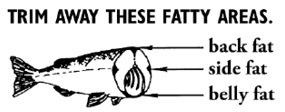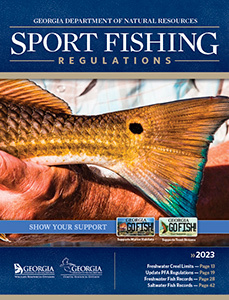Fish Consumption Guidelines: Georgia Waters
The Health Benefits of Eating Fish
Sport fish caught in Georgia are generally good quality and safe to eat. Fish provide a high protein, low fat diet which is low in saturated fats. Fish may have substantial health benefits when they replace a high fat source of protein in the diet.
What are the Guidelines?
Georgia DNR samples fish from water bodies each year to test for contaminants such as PCBs, chlordane, and mercury. Many of the fish tested have few or no contaminants and are safe to eat. Waters where fish have been tested and found to be clean are listed to the right. Fish from waters listed in the tables had some level of contaminants so you should restrict the amount of fish you eat from these waters. Recommendations are made to limit how often you eat a meal of fish from these sources to either once per week or month. A meal of fish is about 4 to 8 ounces. These guidelines are based on eating fish from a listed area for at least 30 years. That is because it would take months or years of regularly eating contaminated food to accumulate levels in your body that would affect your health.
“One meal per week” means that eating a 4- to 8-ounce serving no more than once per week should cause no significant health risks.
Special Notice for Pregnant Women, Nursing Mothers and Children
If you are pregnant or a nursing mother, or plan to become pregnant soon, you and also children under 6 years of age are sensitive to the effects of some contaminants. Women and children in these categories may wish to eat fish less often than recommended in the tables.
How to Reduce Your Health Risk
Eat smaller fish and vary the kind of fish you eat. Contaminants build up in top predators (bass), bottom feeders (catfish), and older (larger) fish to a greater extent than panfish, such as bream and crappie.
Clean and cook fish properly. Some chemicals have a tendency to concentrate in the fatty tissues of fish. By removing the fish's skin and trimming the fat, you can substantially reduce contaminants.

Cook fish so fat drips away. Broil, bake, or grill fish and do not use the drippings. Deep-fat frying removes some contaminants, but discard the oil once you have cooked the fish. Pan frying removes few contaminants.
Guidelines for Georgia
The following tables list the current guidelines for eating fish for lakes and rivers in Georgia. Please note: Lakes and rivers listed on this page (above) have been tested and the fish found to contain little or no contamination. If the lake or stream where you fish is listed in the following tables (on Fish Consumption Guidelines), it is safe to eat the amount listed for a given species from that body of water. Water bodies are listed alphabetically.
No Consumption Restrictions
Fish have been tested from the following water bodies and no restrictions on consumption are recommended.
Lakes
City of Adairsville pond; Allen Creek WMA Ponds A and B; Brasstown Valley Kid Fish Pond; Bowles C. Ford Lake (Savannah); Clayton Co. Water Auth. lakes; Dodge Co. PFA; Fort Yargo State Park; Hard Labor Cr. State Park (Rutledge); High Falls Lake; Mayer (City of Savannah); McDuffie PFA (East); Nancy Town Lake; Olmstead; Paradise PFA (Patrick and Horseshoe 4); Payton Park Pond; (Valdosta); Rocky Mountain PFA Lakes Antioch (East and West); Seed; Marben PFA (CEWC) Lakes Shepard, Margery, and Bennett; and Walter F. George; Silver Lake WMA.
Rivers and Creeks
Alcovy River; Boen Creek (Rabun Co.); Brasstown Creek (Towns Co.); Broad River; Buffalo Creek (Carroll Co.); Butternut Creek (Union Co.); Cane Creek (Lumpkin Co.); Chattanooga Creek; Chattooga River (NW Ga.); Chickasawhatchee Creek; Coleman River; Conasauga River in Cohutta Forest; Dukes Creek; Daniels Creek (Cloudland Canyon State Park); East/South Chickamauga Creek; Goldmine Branch; Jacks River; Jones Creek; Little Dry Creek (Floyd Co.); Little Tallapoosa River; Little Tennessee River; Mill Creek (Whitfield Co.); Moccasin Creek (Lake Burton Trout Hatchery); Mud Creek (Cobb Co.); Nickajack Creek; Noonday Creek (Cobb Co.); Ocmulgee River (Butts, Monroe and Pulaski Cos.); Oconee River (below Barnett Shoals to Lake Oconee, Laurens Co. and Milledgeville to Dublin); North and Middle Oconee Rivers; Olley Creek; Ponder Branch (Walker Co.); Proctor Creek (Cobb Co.); Slab Camp Creek (Oconee Co.); South River (Hwy 36, Butts Co.); Spirit Creek; Stamp Creek (Pine Log WMA); Stekoa Creek; Yahoola Creek; Yellow River; Sewell Mill Creek (Cobb Co); Tallulah River; Upatoi Creek; Tributary to Cedar Creek (Hart County WMA); Headwaters of Chestatee River (Turner’s Corner); and Hayner’s Creek (Savannah).
“These guidelines are non-binding recommendations EPD determines based on the body of water a fish comes from, the species of fish and the amount of fish a person consumes. The purpose of these guidelines is to provide detailed information in an understandable format for people who eat fish. Waters listed in the fish consumption guidelines are not necessarily assessed as impaired using USEPA guidelines for Section 303(d) of the Clean Water Act.”
More details and most recent results from fish contaminant testing are available in the publication “Guidelines for Eating Fish from Georgia Waters” available at:
Call for a copy or more information:
Environmental Protection Division: 404-656-4713 | Coastal Resources Division: 912-264-7218 | Wildlife Resources Division: 770-918-6406

